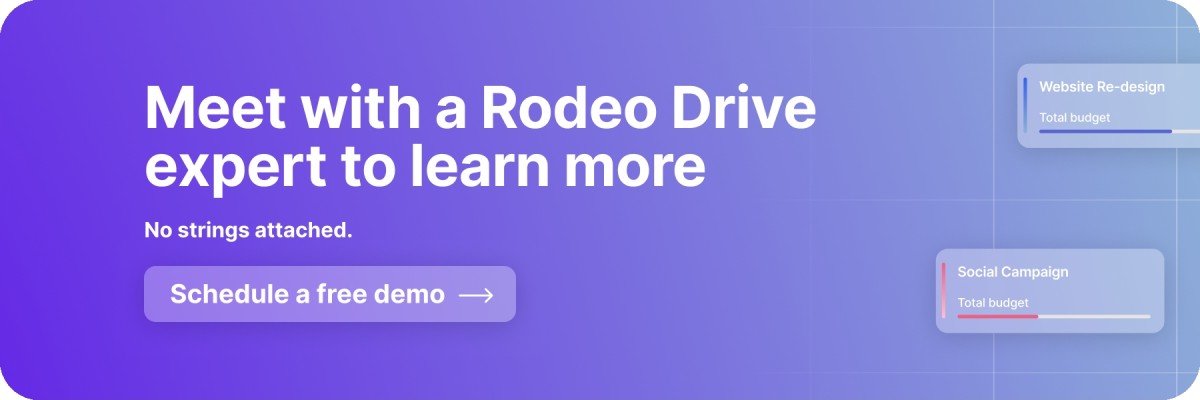Choosing the Right Project-Based Pricing Strategy for Success
Pricing your projects right can be challenging. If you charge a high price, current and potential clients might think twice about hiring your services. Pricing too low could give the wrong impression that your services are not good enough, harming your revenue and the company's future.
It's a decision that demands careful consideration. This article delves into the critical considerations teams must weigh when selecting a project-based pricing strategy. We'll explore how to define the right fee while providing insights to help you navigate the complex terrain of pricing in the project-based industry.
What is project-based pricing?
Project-based pricing, or PBP for short, is when you set a fixed price for getting a service done.
PBP is common in software development, web design, graphic design, and digital marketing.
This approach provides clarity for both the service provider and the client, as the cost is established upfront and is tied directly to the defined deliverables or outcomes of the project.
Picking the right project-based pricing is super important. It's about making sure you cover your costs, make a profit, and keep things sustainable, all while offering a competitive price that fits with what others in the market are charging.
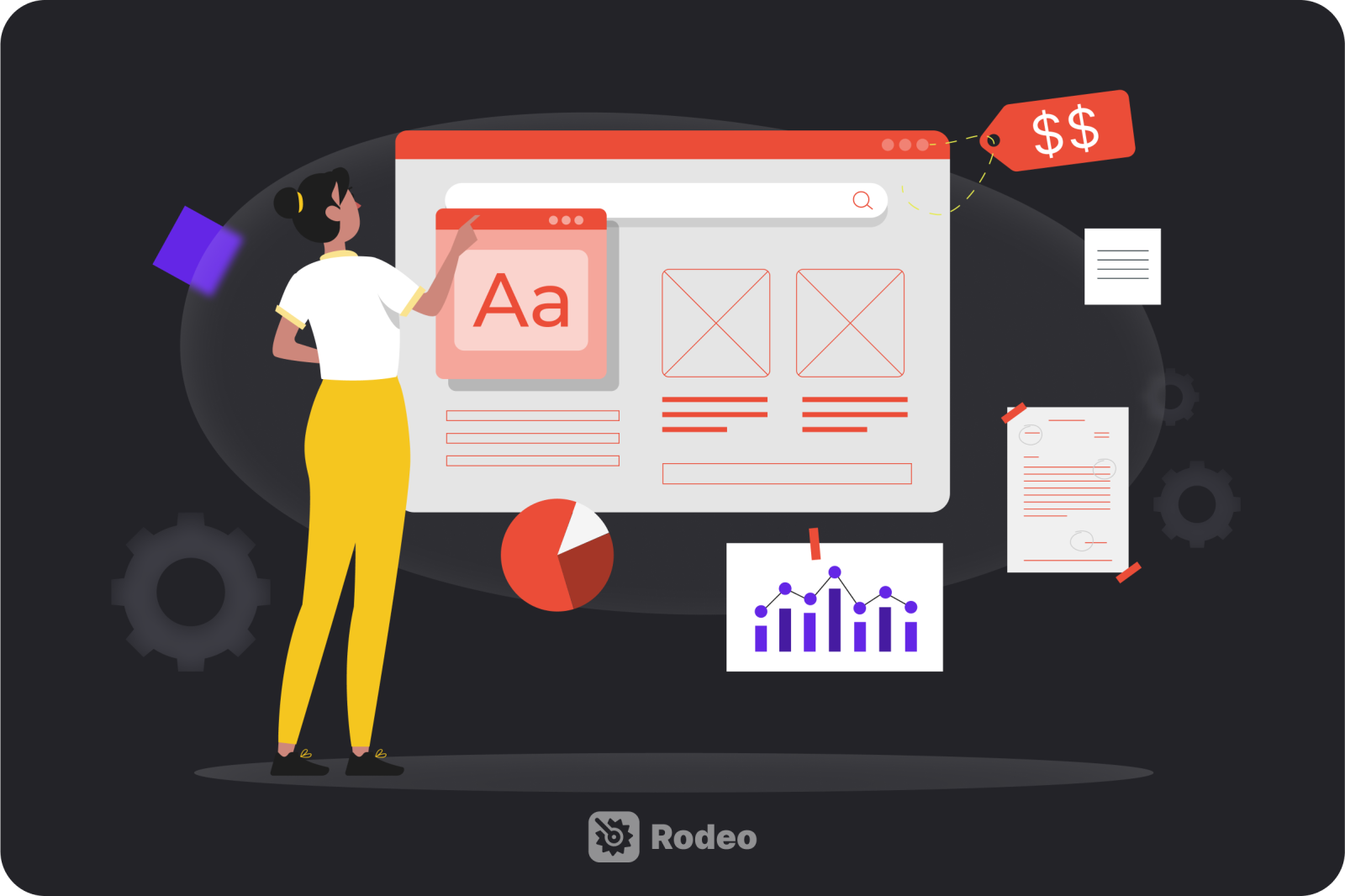
Why having the right pricing strategy is essential to your business
The right pricing strategy is like having the perfect hiking gear – it can make or break the journey. It's the cornerstone of success because it directly impacts revenue, profitability, and customer satisfaction.
Get it right, and you're on a smooth path to long-term growth. Get it wrong, and you could be stumbling over financial hurdles and struggling to keep up. A well-thought-out pricing strategy ensures you cover your costs, make a profit, and stay competitive in the market.
A solid pricing method has some other clear benefits:
- Competitive advantage: A carefully crafted pricing model can help a business stand out in the market. It allows them to position themselves based on factors like quality, value, or unique features.
- Team motivation and morale: Having the right pricing strategy isn't just good for business; it's good for your team. It sets the stage for success, ensuring everyone's efforts are directed towards a common goal. Fair pricing means your team can see the direct results of their efforts. It's like a pat on the back for a job well done, boosting morale and motivation.
- Client perception: The price of a product or service often conveys a perception of its quality and value. A well-considered pricing strategy can influence how people perceive your company as a brand.
- Revenue forecasting: A pricing strategy helps in forecasting revenue. It provides a basis for estimating client volumes, revenue streams, and profit margins.
- Supports marketing efforts: Pricing is a critical element of marketing. It can be used to highlight promotions or special offers, driving growth and attracting new clients.
Project-based pricing vs. other pricing strategies
Project-based pricing contrasts with other pricing models, such as hourly billing or retainer-based arrangements, which are based on the time spent on a project or a continuous commitment to provide services over a specified period.
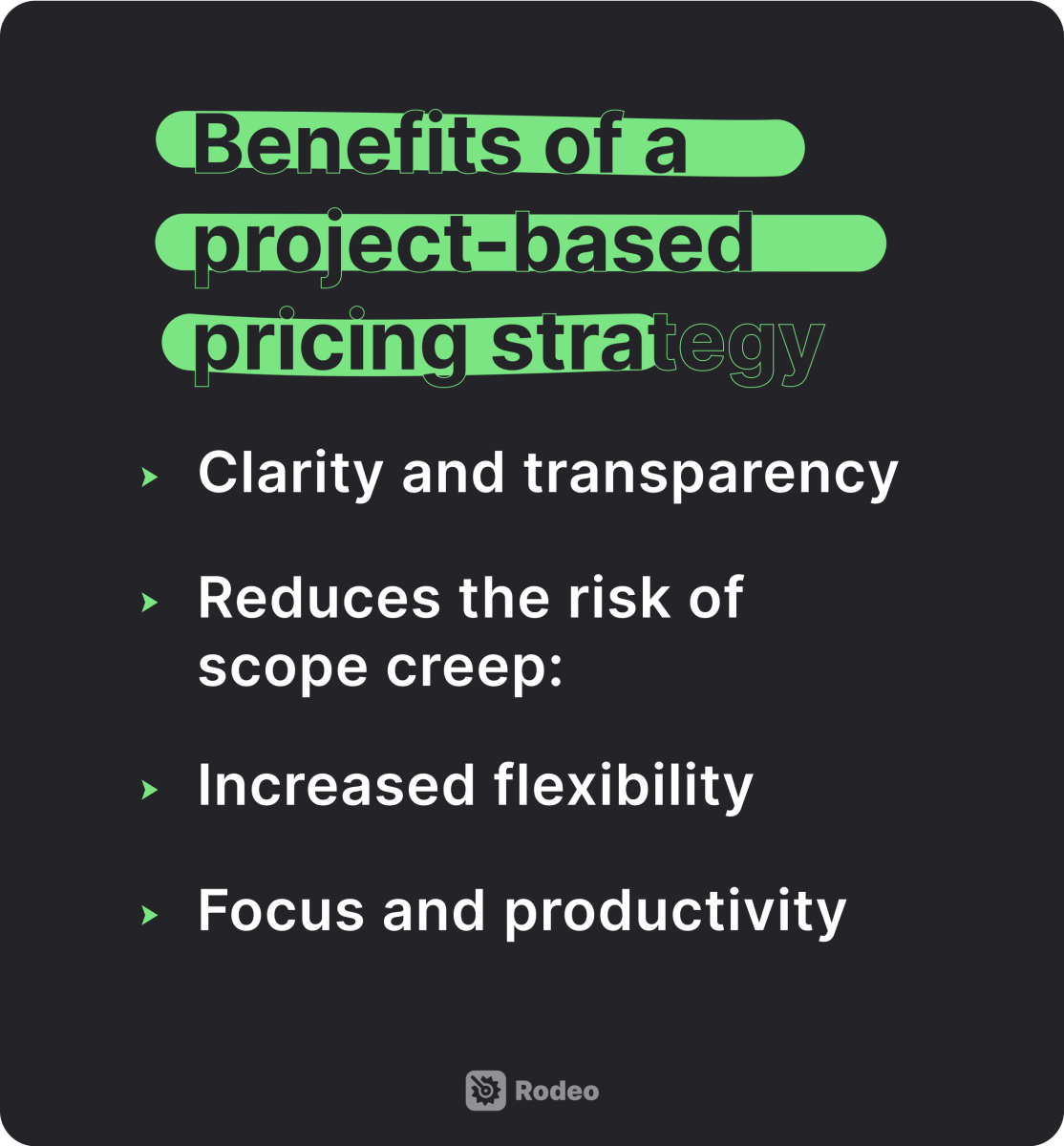
Before we dive into other pricing strategies, here’s a look at some benefits of a project-based pricing strategy:
- Clarity and transparency: With a fixed price agreed upon upfront, both parties know exactly what to expect in terms of costs. There are no surprises or hidden fees, which builds trust and transparency.
- Reduces the risk of scope creep: It encourages both parties to clearly define the project scope, leading to a better understanding of expectations and deliverables. Before the client agrees on the project proposal, you define the scope of work, the budget and the timeline. With everything crystal clear from the get-go, there’s less risk of a project growing uncontrollably.
- Increased flexibility: Using a project-based pricing approach lets you get creative with tailoring projects to fit each client's needs. Plus, it sets the stage right from the beginning. After listening to your client’s wishes, everyone's on the same page about what to expect, which lays the foundation for great working relationships with your clients.
- Focus and productivity: With project-based pricing, the focus shifts towards achieving specific outcomes and delivering high-quality work rather than simply tracking hours worked. This can lead to a higher level of dedication, increased creativity, and attention to detail.
Now, let’s have a look at some other common pricing strategies:
Hourly pricing
Hourly pricing is a straightforward way to charge for your services. Essentially, you set an hourly rate for your work, and you bill the client based on the number of hours you put in. It's like getting paid for every hour you're on the clock.
The pros and cons:
You charge an agreed-upon rate for each hour you work on the project, and you tally up the hours and bill accordingly.
- Pro: You're paid for every hour you put in, and if the project expands, you're compensated for the extra time.
- Con: Clients might get antsy about how many hours you're clocking, and they might be hesitant about costs if the project timeline isn't crystal clear.
Retainer
Retainer pricing is like having a membership for your services. Your client pays a set fee regularly, usually monthly. This fee covers a specific amount of work or a defined scope of services.
The pros and cons:
- Pro: It provides a steady and predictable income stream for you. Plus, it fosters an ongoing relationship with the client, which can lead to more stability in your business.
- Con: It can be a bit inflexible, especially if the client's needs fluctuate monthly. Also, if the client doesn't use all the hours or services included in the retainer, you might not get paid for them.
Competitive pricing
Competitive pricing is about setting your product or service prices in a way that's attractive to customers while still ensuring your business remains profitable.
The pros and cons:
- Pro: It helps you stay in the game and be a competitor to other companies. If your prices are too high, you might lose customers. If they're too low, you might not cover your costs.
- Con: Relying solely on competitive pricing might turn your business into a price war battleground. It's essential to also consider factors like quality, value, and unique features.
Dynamic pricing
Dynamic pricing is all about adjusting the prices of your products or services in real time based on various factors like demand, availability, customer behaviour, and even competitor pricing.
The pros and cons:
- Pro: It allows you to maximise revenue by capitalising on high-demand periods. Plus, it can help you clear inventory during slower times.
- Con: It can be tricky to implement and manage, and customers might feel like prices are unpredictable. You'll need to communicate your pricing strategy clearly.
Value based pricing
You're not just selling a product; you're selling a solution that addresses a specific problem or fulfills a unique need. The pricing depends on what the client is willing to pay. When done right, it's a win-win – your client gets immense value, and you're rewarded for the impact you deliver.
The pros and cons:
- Pro: It allows you to capture the true value of your expertise, innovation, or unique solution. Plus, it often leads to higher profit margins.
- Con: It can be tricky to figure out the "right" value. You'll need a deep understanding of your client's needs and the impact your offering will have.
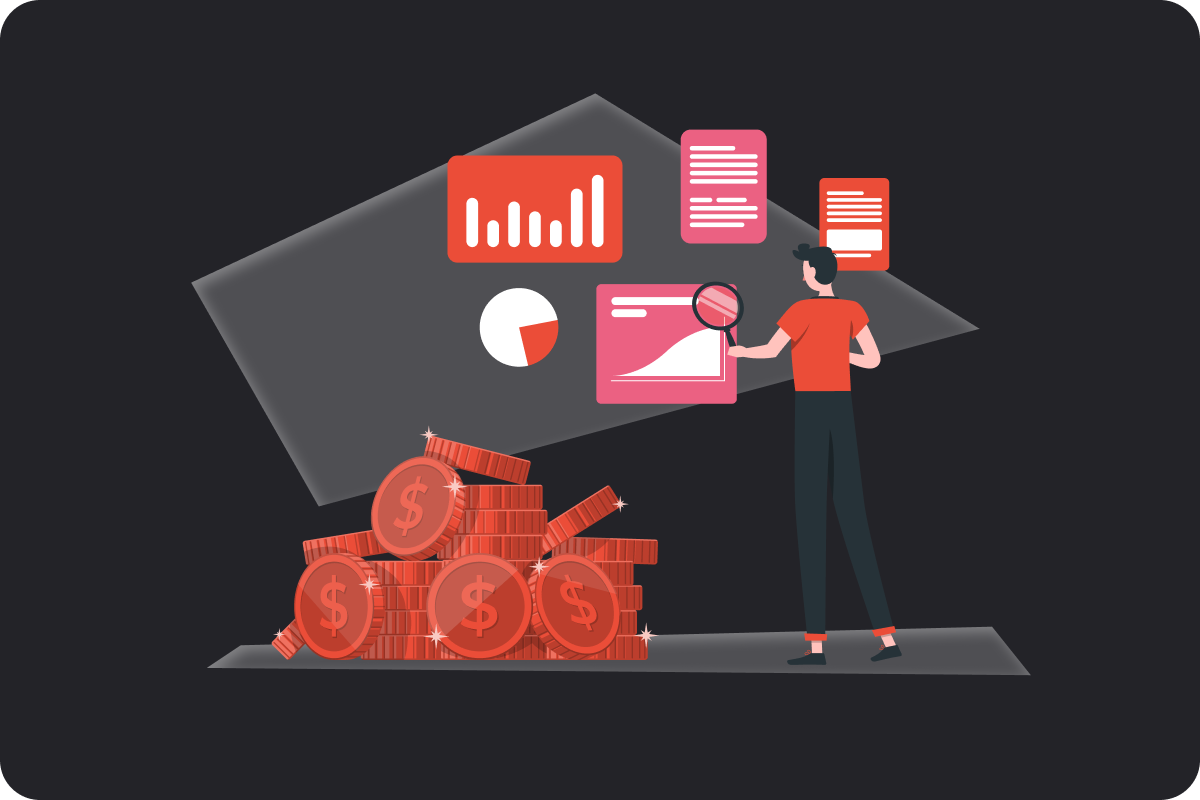
Finding the right project pricing approach
Ultimately, the right pricing strategy depends on your specific business model, target market, and the perceived value of your offerings. It may even involve a combination of these methods for different products or services.
Finding the right pricing approach is a blend of experience and research. It's about balancing your costs, client expectations, and market rates to arrive at a figure that's fair for both parties.
Here's how you can go about it:
1. Understand client expectations
Start by having a clear conversation with your client about their budget, their expectations, and what they consider valuable in the project. This will help align your pricing with their needs.
This project meeting is also a great time to clearly articulate the value your team provides. This goes beyond the project deliverables and includes benefits and outcomes. Understanding what your team brings to the table allows you to align pricing with the perceived value.
If you get the green light, make sure to establish achievable expectations and proactively ask about assumptions during client onboarding to prevent any conflicts later on, as the client might have their own interpretation of how the project will unfold.
2. Define the scope
Clearly outlining your project scope is a critical component of any project planning process. It serves as a means for project stakeholders and team members to come to a consensus on what the project encompasses. This prevents scope creep, where the project gradually expands beyond what was originally agreed upon.
Understanding the scope allows you to position your pricing strategy with competitors.
It enables you to highlight what sets your offering apart and justifies the costs.
3. Know your costs
Start by understanding all the expenses associated with the project. This includes direct costs (like materials or software licenses) and indirect costs (like labour).
Understanding your costs allows you to set prices that cover all expenses associated with producing the agreed-upon deliverables. This ensures that you generate a profit and establish a baseline for the minimum price you can charge to avoid operating at a loss. This prevents underpricing.

4. Consider your expertise
If your team brings a unique skillset or extensive experience to the table, it's fair to factor that into your pricing method.
Expertise sets you apart from competitors. It allows you to position yourself as a specialist in your field, justifying potentially higher prices due to the depth of knowledge and quality of work.
On top of that, recognising the value of expertise encourages ongoing professional development in your company. This continuous improvement reinforces your ability to offer top-tier services, further justifying your way of pricing.
5. Consider long-term goals
Think about how this project fits into your long-term business goals. Are you looking to build a long-term relationship with this client, or is this a one-off project?
If the company’s goal is to expand into new markets or diversify offerings, the pricing strategy should be flexible enough to accommodate these strategic initiatives. It should also allow for testing new markets without compromising profitability.
6. Factor in contingencies
Always leave room for unexpected issues or changes. It's a good practice to include a buffer in your pricing. Contingencies act as a safety net, helping to manage risks associated with factors like market fluctuations, disruptions within the team, or unexpected changes in client requirements.
While this might be something project managers don’t want to mention to their clients, including contingencies in pricing demonstrates a level of professionalism and thoroughness. It shows that the company has considered various scenarios and is prepared to handle unexpected challenges and deliver project success.
7. Communicate clearly
Be transparent with your client about your pricing approach and how you've arrived at the final figure. This builds trust and avoids any surprises down the line.
If projects can span a considerable length of time, maintaining strong client relationships becomes crucial. Effective client management is instrumental in ensuring a consistently exceptional experience for the client throughout this extended period.
8. Evaluate and adjust
After the project is completed, take the time to evaluate if your pricing was accurate. Did you cover your costs and make a profit? Use these numbers to refine your approach for future projects.
Your clients might have feedback as well on whether your deliverables have justified the price.

Tips for finding the right pricing strategy
Finding the right pricing strategy is a dynamic process. It requires a combination of data analysis, customer understanding, and business acumen. Don't be afraid to revisit and adjust your pricing strategy as your business evolves. It's a critical element of your business's overall strategy for success.
Know your value proposition
Knowing your value proposition helps you differentiate yourself in the market. It allows you to highlight what makes your offering unique and justify potentially higher prices or a different pricing method based on the added value you provide.
Plus, depending on your value proposition, you may have flexibility in how you structure pricing and diversify your client base at the same time. For instance, a premium package may warrant higher prices, while a budget option could cater to a different range of clients.
Research your market
Clearly define what sets your product or service apart. Understand the unique value you bring to your customers. While raising your project rates alone or going for a different pricing method doesn't guarantee improved project profitability, it's advisable if you find that your rates are lower than those of your competitors.
One effective way to gauge your position in the market is by conducting a thorough competitor analysis. This entails examining what your closest competitors charge for similar services, understanding their typical client base, evaluating their client capacity, and assessing their online reputation through reviews.
If you observe that they charge more for comparable services while still maintaining satisfied customers and delivering value, it may be a signal that it's time to adjust your rates or pricing options. At the very least, it's recommended to review and potentially revise your rates every few years to accommodate inflation.
Consider client perceptions
Understand how your pricing is perceived by customers. Are you positioning yourself as a premium offering, a budget-friendly choice, or something in between?
Different clients may have varying levels of price sensitivity. Some may prioritise hourly rates for their bookkeeping and are willing to pay more, while others may be more budget-conscious and prefer a flat fee. Tailoring pricing to accommodate these perceptions can help capture a broader range of clients or tap into a new market.
Test, then test some more
A pricing strategy has to work for you and your client. Determining the optimal pricing for projects is a multifaceted endeavour that may involve some experimentation. Your (potential) clients and their feedback are a crucial facet of this process.
Don't be afraid to experiment with different pricing strategies. You can adjust as you gather data on customer response and financial performance. This data-driven approach ensures pricing decisions are based on actual market responses rather than guesswork.
Monitor market changes
Keep an eye on industry trends, customer behaviour shifts, and competitor pricing changes. Stay adaptable. Markets are dynamic, and what worked yesterday may not work tomorrow. Testing pricing strategies allows businesses to adapt to changing market conditions, consumer preferences, and competitive landscapes.
Factor in seasonal and economic variables
Consider how external factors like seasonality or economic conditions might influence your pricing decisions. Establish regular intervals for reviewing and adjusting your pricing strategy based on these changes.
Inflation will always be a factor to consider, but also think about seasonal demand increases such as Christmas commercials or creating deliverables for a campaign about waiting times at the airport over the busy summer months.
Using Rodeo Drive to put the right price on your projects
Your project might seem profitable at first, but tallying up the hours and expenses might tell you otherwise. Rodeo Drive consolidates project budgeting, time tracking, reporting, and invoicing all in one platform.
Phase-based budgeting
Crafting a comprehensive project budget is essential for avoiding unnecessary expenses. With Rodeo Drive, budgeting becomes a breeze as it enables users to create a phased budget, breaking down costs into manageable segments.
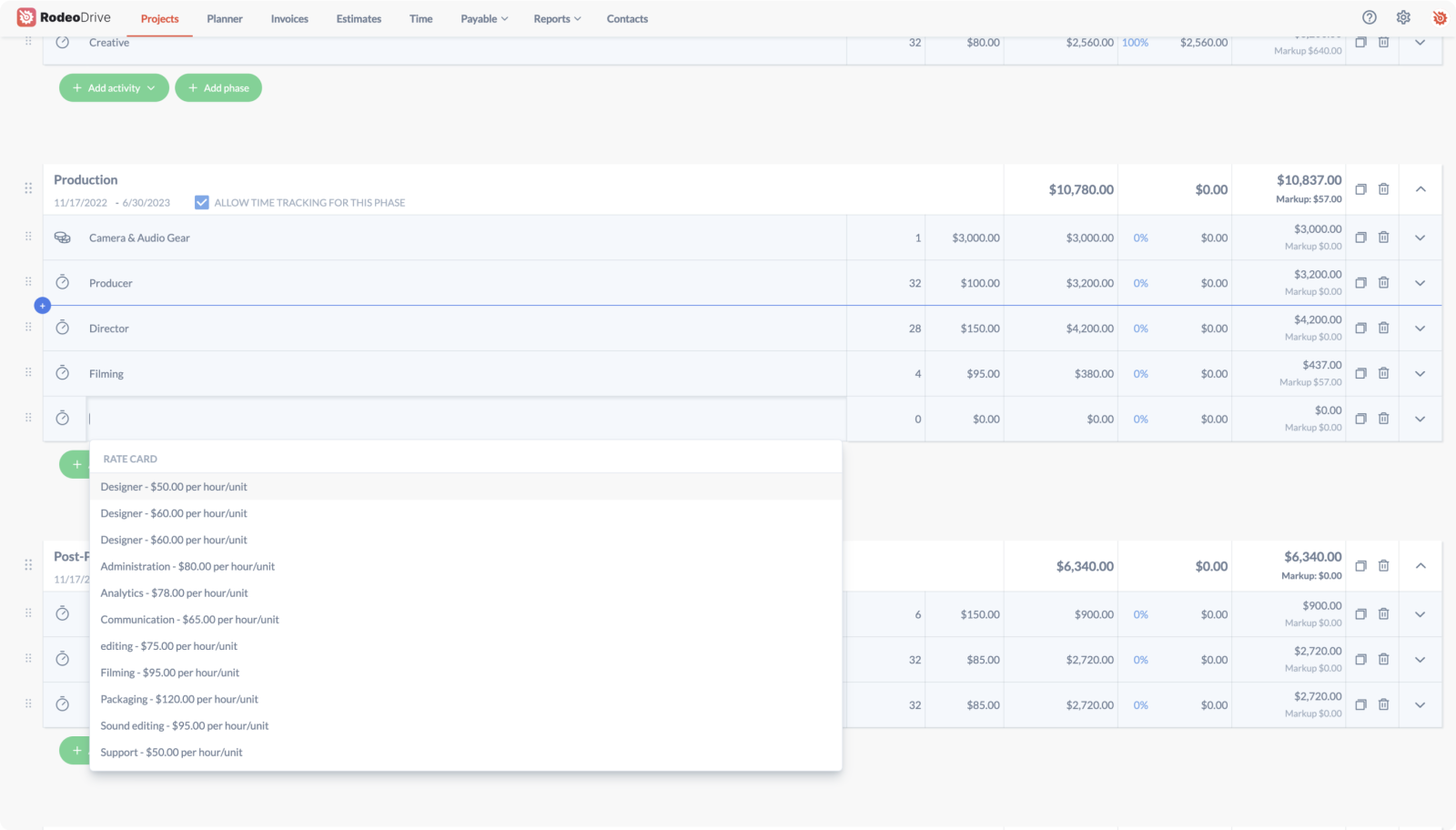
Time tracking connected to your budget
Finding the right price for your projects hinges on efficient time tracking. Rodeo Drive provides users with two options for time tracking: a live timer for real-time task tracking or the ability to manually input timecards later.
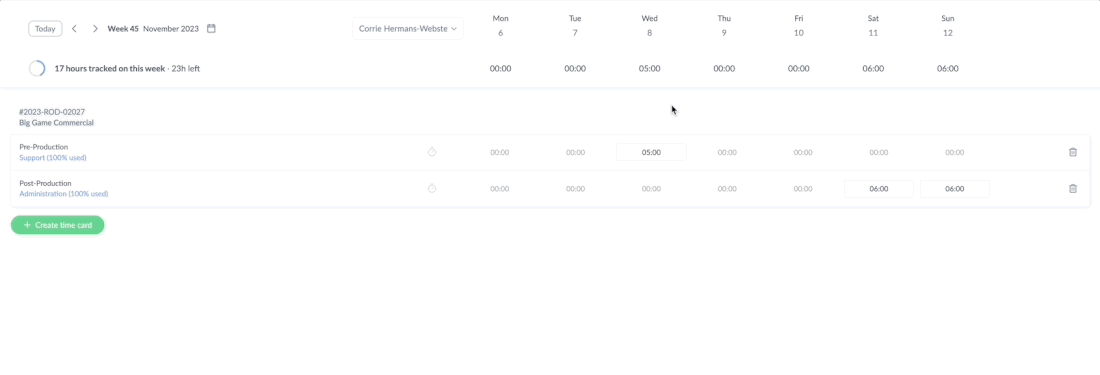
What's even better is that your budget syncs with your team's logged time, ensuring it stays current based on the actual time spent on project tasks.
So, if a specific task ends up taking double the anticipated time, this overspending is promptly reflected in your budget. This gives you the ability to promptly make any needed adjustments to maintain budget adherence and change the pricing strategy if needed.
Monitor the financial health of your project
Real-time reporting is a valuable tool for tracking your project's progress and sharing with your stakeholders.
Rodeo Drive consolidates all your team's project data. This gives you a quick overview of project expenses, time allocations, and staff efficiency. Additionally, you have the option to refine these reports based on project status, dates, or client.
.png)
If you wish to generate custom reports, you can easily export the data in either CSV or Excel format.
Additional features
- Estimates and invoices: Send budget estimates to your clients straight from Rodeo Drive. Ready to get paid for the project phase or completed project? Bill clients directly from Rodeo Drive in the UK and via QuickBooks integration in the US.
- Client contact management: Keep your vendor and client contact information, rate cards, and points of contact organised in Rodeo Drive.
- Time tracking: Start your live timer when you begin a project activity or add a timecard after the fact and book billable hours.
Pricing
Rodeo Drive offers two pricing plans:
- Free plan: Up to 10 users, 3 active projects, task management, and more
- Achiever plan ($14.99 per user/month): Everything in the free plan, plus unlimited active projects, unlimited storage, custom templates, free guest users, and more
But don’t just take our word for it — come and see Rodeo Drive for yourself.






